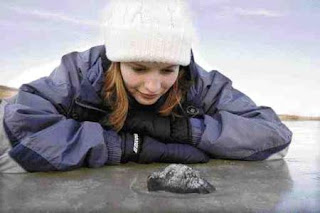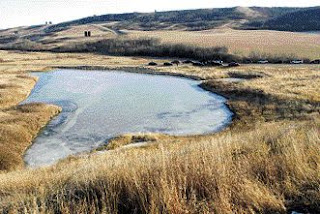Now an update.

... the hills rise wild ... with deep woods ... dark narrow glens ... farms, ancient and rocky ... It all began, old Ammi said, with the meteorite. Before that time there had been no wild legends at all ... till the strange days. Then there had come ... explosions in the air, and ... by night all ... had heard of the great rock that fell out of the sky and bedded itself in the ground ... {from The Colour Out of Space, HP Lovecraft}
Grad student wins space race: Fragments of fireball that exploded over Prairies found on frozen pond (excerpt from Keith Gerein, The Edmonton Journal; Published: Saturday, November 29, 2008 )
LONE ROCK, SASK. -
...Small, blackish lumps on a frozen pond are the kind of sight easily dismissed while driving along rural roads in Saskatchewan.
Yet the University of Calgary master's student was immediately intrigued, knowing these lumps were in the area where a meteor was thought to have exploded last week. Stopping the car, she and her travel partner -- U of C meteorite expert Alan Hildebrand-- gingerly stepped on the ice for a closer look.
The first lump they investigated turned out to be a leaf. The second was a stone, but of inconclusive origin. But there was no doubt about the third. Hildebrand recognized it instantly as a cosmic treasure -- a 250-gram piece of frozen space rock.
"He looked at me and said, 'Yes, this is definitely a meteorite,' " said Milley, who found the fragment about 3:50 p.m. Thursday in a picturesque valley known as Buzzard Coulee.

... The sloping property a few kilometres from the Alberta border is part of a cattle ranch owned by Ian Mitchell. ... The fragments, which can be worth thousands of dollars, belong to the owner of the land on which they fall. ... Space rocks are typically named after where they are found.
The fireball caused a stir in Alberta and eastern Saskatchewan on Nov. 20. ildebrand estimated the rock weighed 10 tonnes as it descended to Earth, breaking up in a series of spectacular explosions before hitting the ground. The fireball first appeared about 80 kilometres above and just east of Lloydminster, then moved south.
Based on this information, Hildebrand identified an area of about 20 square kilometres near Battle River for a probable impact site. It was in this search area that Milley spotted the first pieces.
A preliminary analysis shows the meteorite to be a fairly common type of space rock, Hildebrand said. It is believed to have originated as part of a larger asteroid that was formed some 4.5 billion years ago.
"We call it an ordinary condrite," he said. "These are mostly stone, with what I would guess is about 20-per-cent iron metal." Further analysis must be done to learn more about it age, composition and place of origin. Hildebrand said he hopes to get more researchers looking for space rocks. The race is on to find as many as possible before the snow falls, he said.
© The Edmonton Journal 2008

No comments:
Post a Comment